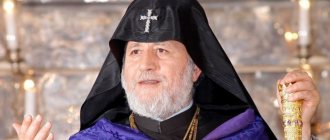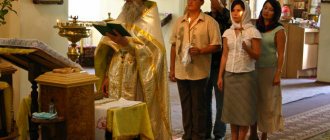Union
(church; lat. unio - union), a merger of the Orthodox and Catholic confessions, and, on the one hand, the primacy of the pope, purgatory, the procession of the Holy Spirit and from the Son (filioque) is recognized, on the other hand, marriage of white clergy and worship in their native language is allowed language, preserving oriental rituals.
In the middle of the century. There followed a complete break between the Eastern and Western churches. Instead of the previous peaceful relations, hostile relations were established between them. Through cruelty and desecration of Greek shrines during the Crusades, the Latins even made these relations hostile. The Greeks hated the Latins as heretics and their oppressors: the Latins, in turn, hated the Greeks as schismatics (as they called them) and as double-minded and treacherous people. Hostility often expressed itself in bloody clashes.
Despite this, the Greeks and Latins often make attempts to unite churches. There were special reasons that prompted them to seek church union. Even after the division of churches, the popes did not lose hope of subjugating the Greek-Eastern Church to their power. In these forms, they strove with all their might to restore communion between the Eastern and Western churches, understanding by restoration of communion not a union of churches, but the subordination of the Eastern Church to the Western Church, or, what is the same, to the pope.
The Greeks, for their part, also sometimes thought about uniting churches, according to political calculations. The political situation of the Byzantine Empire since the 12th century. it was extremely difficult. The decrepit empire, under the blows of the Turks and crusaders, was inclined to fall. Counting, with the assistance of the popes, to protect the empire from numerous enemies and protect it from fall, Byzantium sought an alliance with Rome; and since the popes could not be won over in any way except by expressing readiness to unite the churches, with the subordination of the Eastern Church to the Western, the Byzantine government in all negotiations with Rome brought to the fore the issue of uniting the churches.
Thus, on both sides, calculation played the main role in mutual attempts, and this alone did not promise them success. The fragility of attempts to unite churches was also due to the fact that they did not have the character of universality, at least in the East. On the part of the Greeks, it was the emperors who were mainly concerned about the union of churches, but the majority of the Greek hierarchy and the people were always against the union, since they saw in it the subordination of the Eastern Church to the pope.
Of the many attempts to unite churches, generally unsuccessful, three are especially remarkable, brought to the end by all kinds of tricks and violence and accompanied by sad consequences for the Orthodox Church, these are:
- Union of Lyons (1274)
- Union of Florence (1439)
- Union of Brest (1596)
Classification of agreements
Real union is an alliance that monarchies enter into, simultaneously accepting a single order of succession to the throne. The heir apparent is the future monarch for all countries party to the agreement. Such a union - strong, reliable - can only be dissolved if one of the participants changes the form of government to a republican one. The abolition of monarchical power in one or all member states entails the disintegration of the union or a reduction in its quantitative composition.
A personal union is an agreement that is made by chance when one person becomes monarch in several states as a result of his kinship with two or three rulers or as a result of necessity. The procedure for succession to the throne has not changed or been unified in the participating countries. Such a union is doomed to collapse. Sooner or later, a contender for the throne will reign in one state, but in another it may be impossible due to the peculiarities of the legislation.
Church union is a type of agreement that is concluded between denominations. The goals and reasons for the union depend on historical circumstances.
Union and confederation: what is the difference?
This form of unification is often equated to a confederation. It is worth noting that such an identification is not correct.
Firstly, union can only arise with the participation of monarchical states. This is its main feature. As for the confederation, republican state entities can also join such a union.
The existence of a union does not require close political or economic cooperation. Alliance agreements are not mandatory. The situation is different with the confederation. By signing an agreement, its members have certain obligations to each other. Participants in the union do not lose state sovereignty. A single ruler-monarch increases his power. After signing the union, he is the bearer of the sovereign rights of each country included in the union.
An important detail of the legal aspect of signing a confederation treaty is the existence of an agreement with specified mutual obligations. This guarantees political unity. And a union is a community that can be concluded without an agreement.
An important feature also concerns the conduct of hostilities between the parties to the agreement. Member states of the union cannot fight each other, since the ruler is one, therefore, by declaring war within the union, he undertakes to attack himself.
The struggle between the Uniates and the Orthodox
For almost 40 years after the signing of the Union of Brest, there was a fierce struggle between its supporters and opponents.
Lands, temples, and church buildings were taken away from the Orthodox Church. Brotherhoods led by active laymen and clergy came to their defense. The Vilna Brotherhood, located in the Holy Spirit Church, resisted especially strongly. After 1609, it was the only Orthodox church in Vilna (now the capital of Lithuania, the city of Vilnius).
The confrontation was so fierce that it led to bloody clashes. In 1618, a powerful uprising began in Mogilev, directed against the policy of imposing Uniatism. And in 1623, the residents of Vitebsk literally tore to pieces the Uniate Archbishop Josaphat Kuntsevich, who came to their city and actively persecuted the Orthodox.
Despite the brutal suppression of the uprisings, resistance did not stop. The Catholic Church was forced to make concessions. In 1633, King Vladislav IV issued a privilege allowing Orthodox Christians to build churches and practice their faith.
Political unity and dynastic agreements
History knows many cases of concluding such alliances. One of the earliest, most famous and significant is the Krevo Union. Lithuania and Poland were parties to the agreement. Like many other unions, this one was sealed by a dynastic marriage, which was concluded by the Polish Queen Jadwiga and the Grand Duke of Lithuania Jagiello.
The Union of 1385, signed at Krevo Castle, introduced certain changes to the structure of both participating countries.
The reasons for the conclusion of the alliance were the weakening of both states and the pressure that was exerted on them from the outside: from the Teutonic Order, Muscovy, and the Golden Horde. Even before the Union of Krevo, Lithuania signed several agreements with both the Moscow prince and the Teutons, which should have significantly influenced the course of events, but were not implemented.
Supporters and opponents of the union
Even before the merger agreement was signed, 3 positions were clearly identified:
- Ardent lobbyists for an alliance with the Catholic Church.
- Supporters of signing an agreement on the terms outlined by the bishops in the summer of 1595.
- Categorical opponents of the union.
After Rome rejected all the proposals of the hierarchs of the Western Russian Church, the number of opponents of the union increased.
One of the main lobbyists for the unification of churches was Bishop Ipatiy Potey of Vladimir and Berestey. In 1599 he was appointed head of the Uniate Church.
Another active supporter of the union was Bishop of Lutsk and Ostrog Kirill Terletsky. In 1595, together with Hypatius Potei, he traveled to Rome, where he swore allegiance to the pope.
The head of the Kyiv Metropolis, Mikhail Rogoza, took a more restrained position. But he was forced to submit to the will of the Polish king Sigismund III. In 1596, Rogoza signed the act of the Union of Brest and became the first head of the Uniate Church. He held this post until his death in 1599.
The resistance to the union was led by the Lithuanian magnate, Kiev governor Konstantin Ostrozhsky. Two Orthodox bishops also refused to convert to Uniatism. These were the head of the Lviv diocese, Gideon, and Bishop Michael of Przemysl. The basis of the Uniat protest base was made up of ordinary priests and laity.
The essence of the agreement in Krevo
According to the agreement, Jagiello became the king of Poland. This imposed a number of obligations on him:
- The new ruler pledged to spread the Latin alphabet in Lithuania.
- Jagiello had to pay Duke Wilhelm of Austria compensation for a broken marriage contract, according to which the latter had to take Jadwiga as his wife.
- It was necessary to introduce Catholicism in Lithuania.
- Jagiello was supposed to return the lands of former Rus' to Poland and increase the territory of the kingdom. The Lithuanian and Polish union obliged him to increase the number of prisoners.
Simply put, Jagiello became a single ruler for Lithuania and Poland, but at the same time the monetary system and treasury, legislation, customs rules remained separate, there was a border, there were separate armies for each member state of the agreement. The Union of Krevo caused disagreement on the part of the nobility of Lithuania and former Rus', but served as the basis for the union in Lublin. The territory of Poland increased.
Historical background of the Union of Lublin
For many years after the signing of the treaty in Krevo, there were disputes between the Lithuanians and the Polish gentry over the rights and level of influence in the country. As land ownership increased, the structure of the privileged class in both countries also changed. For the two states there were different features of the development of the feudal class: the Polish gentry was homogeneous, all its representatives were endowed with equal rights, and all differences were eliminated; Lithuanian tycoons are a polarized class. By “poles” we mean two types of nobility:
- Large landowners (magnates) who had virtually unlimited rights and privileges. They were not subject to local courts - only to the court of the Grand Duke. In addition, they could occupy the most important positions in the state. In addition to the huge amount of land, they had significant labor reserves at their disposal.
- Small and medium landowners. They did not have the same political and economic leverage as the first group (less land, labor, opportunities). In addition, they often became victims of the greed of large tycoons, since they depended on them.
For reasons of thirst for justice (or greater power and influence), representatives of the second group sought the equality that should have been among the gentry.
But the problem was not only the struggle between magnates - representatives of Poland and Lithuania could not always agree on common military campaigns, which made both states vulnerable. The Polish elite were afraid of losing the lands of Lithuania, since the ruling Sigismund Augustus at that time was the last representative of the Jagiellons - a change in the royal family could cause the separation of some territories.
Union in Austria-Hungary
Among the peoples of Austria-Hungary who adhere to the union, the first place numerically belongs to the Rusyns (Ukrainians, Little Russians), co-tribes with the population of southwestern Russia. In the Austrian half of the monarchy they are almost the only representatives of the union, although not all belong to it; in the Hungarian half they make up a significant part of the Uniates.
Until 1772, i.e. Before the first partition of Poland, in the Austrian part there were no Uniates at all, and they were only in Hungary, so the history of the Greek Catholic Church (as it is officially called), as it concerns the Rusyns, is connected mainly with the history of Galicia - a territory densely populated Uniates. The population of Galicia went into union in the second half of the 17th and early 13th centuries; in 1772, only one Basilian (Bazilian) monastery in Manyava remained Orthodox.
The international treaty of 1772 allocated from Poland the dioceses of Przemysl, Lviv (without part of Podolia) and a significant part of Kholm and Lutsk. All of them belonged to the Kyiv metropolitanate, a representative of which remained in Poland, as did the bishops of the last two dioceses.
After the final partition of Poland and the settlement of the borders between Austria and Russia in Austria, the separate existence of the Kholm and Lutsk dioceses was abolished, their remains were annexed to Przemysl and Lvov, and the district of Kamenets-Podolsk was separated from the latter, although the Lvov archbishops retained the title of bishop of Kamenets.
In addition to political motives, these changes were also influenced by the fate of the Uniate Church in Russia. When the Uniate metropolitanate was destroyed in Russia in 1795, the Austrian government restored the former rank of Galician metropolitan and gave it to the Lvov archbishop (1808).
The territory acquired by Austria in 1772 had about 2,700 thousand inhabitants, the majority of whom were Rusyns, i.e. Uniates The national and religious isolation of the majority of the population from the Poles was news to the Austrian government. This circumstance was favorable for government policy regarding the Polish gentry. On the other hand, the Austrian government, regardless of this, had to take care of the church life of its new subjects.
The result of the four-century (religious, cultural and national) struggle of the Rusyns with the Poles was that when Galicia came under Austrian rule, the Greek Catholic Church was in extreme decline. “Latinists” and their various church institutions were scattered throughout the territory. The Uniate clergy was in complete spiritual, material and even social humiliation. This prompted a series of reforms on the part of the Austrian government. It destroyed, first of all, the obligation of the Ukrainian rural clergy, on an equal basis with the peasants, to serve corvee (1777).
The poor financial situation of the Uniate clergy was mainly a consequence of the extreme fragmentation of parishes. The government produced the so-called concentration of parishes, but carried it out on such a scale that the Rusyns began to protest, especially in view of the simultaneous decentralization of Latin parishes. In addition, the government assigned cash subsidies from a specially established (1782) fund to the poorest priests and senior clergy.
The right of patronage was regulated, in the sense of limiting the dependence of the clergy on the landowners (1784). Most of all, the government took care of improving education among the Greek Catholic clergy. Previously, access to this class was very easy, even for people who were barely literate. In 1774, Maria Theresa established St. Barbarians in Vienna so-called “Imperial General Greek Catholic Seminary” for the Uniates of the entire monarchy, the teachers of which were invited mainly Rusyns from Hungary.
This “Barbareum,” as the seminary was usually called, was of great importance throughout its existence for the Uniate Church in Austria-Hungary. Almost all of the most remarkable representatives of the local Ukrainian clergy were students of this institution. They brought from here not only knowledge, but also the spirit of reform that animated the emperor. Joseph II.
In 1784, at the University of Lviv, the same general seminary was established for Greek Catholics from Galicia and Hungary, and at the same time the previous episcopal seminaries in Lviv and Przemysl were closed. And here teaching was carried out in the spirit of the reforms of Joseph II, and the language of instruction was mainly Ukrainian. This seminary existed until the closure of Lviv University in 1806. In 1817 it was restored, but only for Galicians.
The Austrian government also acted as a judge between the white and black clergy in Galicia. Even in Polish times, there was a struggle between them over dominance. The Basilians (monks of the Order of St. Basil) took control of the dioceses. Lviv Bishop Lev Sheptytsky, in order to get rid of their predominance, decided to restore the former “Kriloshan councils” in the form of Latin chapters. Not only the Basilians, but also the Latin clergy rebelled against this. The government sided with the white clergy and established chapters in Lviv (1786, 1813) and Przemysl (1787, 1816). In 1779 it was allowed to elect priests who were not monks as bishops.
A further step in this anti-monastic policy was the closure in 1783 of more than 40 Uniate Basilian monasteries and the last Orthodox one in Manyava; their property was given to a religious foundation. This broke the meaning of the Basilians for a long time.
The same reformation spirit of the government was expressed in the closure of all fraternities (1782); the famous Lviv Stauropegian brotherhood was supposed to change its name and organization and turn into a society under the name of the “Lviv Stauropegian Institute”.
All these reforms significantly raised the material and spiritual level of the Greek Catholic Ukrainian clergy, and the appointment of a special Galician metropolitan raised the prestige of the Uniate Church.
In the 19th century the fate of the latter in Russia forced the Roman Curia to also take care of the Galician Greek Catholics. Metropolitan Mikhail Levitsky was given the title of cardinal (1856); The ban on the transition of Uniates to the Latin rite was confirmed (1863). This defense of the Greek Catholic rite did not, however, give it equality with the Latin; The Latin clergy did not cease to look at the Rusyns as half-infidel schismatics and continued their propaganda among them in favor of Latinism.
All this exacerbated religious antagonism. With all this, due to the lack of Rusyns in the first half of the 19th century. national self-awareness, higher education led their clergy to polonization. In 1772, the poor and ignorant white clergy still had a national Ukrainian character, but the higher educated clergy from the Basilians was almost completely denationalized. Later, almost all the clergy suffered the same fate.
A reaction against such an anomaly began among the clergy of the Przemysl diocese, which was under the administration of Bishop Ivan Snigursky (1818-1847), the most famous figure among the Greek Catholic clergy in all Austrian times. His activities were not limited to the development of national self-awareness among the clergy, but extended to the entire rural population.
The literary revival of the Rusyns had its first representatives only among the clergy (M. Shapshevich, Y. Golovatsky, I. Vagilevich, M. Ustyanovich, etc.). In 1848, the Rusyns clearly stated their national-political demands for the first time (Gr. Yakhimovich, Mikh. Kuzemsky, etc.). With the suppression of the revolution, political and religious reaction began in Austria. Thanks to the concordat of the Austrian government with Rome, the Catholic clergy acquired privileges unprecedented since the time of Joseph II in the fields of politics and public education (1855-1867).
And the Uniate clergy then acquired the right of supervision over public and secondary schools; but it did not use its powers particularly zealously, while the Latin clergy, in addition to religious propaganda, began to spread polonization in Galicia and Bukovina.
In national-political terms, the Uniate clergy was then distinguished by narrow-mindedness, callousness and stagnation, which came to be designated by the word “ruthenism.” And in terms of ritual, the Uniates began to gradually approach Latinism (the introduction of the holiday of Corpus Christi in 1854). The desire of the Roman Curia to convert the Orthodox East into a union finally forced the Ukrainian clergy in Galicia to begin to cleanse the Eastern rite of Latin impurities. A hot struggle arose, which for two decades filled the entire spiritual life of the Galician Rusyns. Some of the clergy even began to directly declare their sympathy for Orthodoxy. The case of Olga Grabar (1882), which caused a lot of noise in this sense, prompted the Roman Curia and the Austrian government to undertake reforms in order to bring the Uniate clergy and ritual closer to Catholicism.
The reform of the Basilian monasteries was transferred to the hands of the Jesuits (1882). Metropolitan Joseph Sembratovich, who was an opponent of this measure, had to retire. Under his successor Silvestre Sembratović, who received the rank of cardinal, reforms continued in the same spirit, especially in the field of rituals.
The Council of the Galician Clergy of 1894 returned to the resolution of the Zamoyski Council, according to which, first of all, monks and unmarried people should be appointed bishops. From among the monks came Metropolitan Count Andrei (Sheptytsky) (since 1900).
However, the council resolutely rejected Rome’s demand for general celibacy of the clergy. In 1893, the Barbareum was closed, in its place the College of St. Afanasia. The antagonism between both rites became even more acute. The government and the curia still looked at the union as something inferior compared to Latinism.
In Hungary, the Greek Catholic Church is in no way connected with the Austrian; The Rusyns make up only a minority of the total number of Uniates. They accepted the union in 1649 and constituted one Mukachevo (Munkacs) diocese, subordinate to the Latin archbishop in Eger. The Austrian government here too in the last quarter of the 17th century. carried out reforms in the sense of improving material life and educating the clergy.
The Barbareum and the Lviv General Seminary were for some time institutions common to the entire monarchy. When the Uniate metropolis was destroyed in Russia, the idea arose to establish a metropolis common to all Rusyns in Mukachevo, but when the metropolis was established in Lvov, the Hungarian Uniates were not added to it due to the hostile position occupied by the Magyars, and the Mukachevo diocese remained united with the Latin metropolis.
In 1821 it was divided into two, creating a new one, Presevo (Eperjes). Separate seminaries arose in each of them. Until 1873, a certain number of clergy were delivered to both dioceses by the Vienna General Seminary, until the Magyars put an end to this. And in Hungary from the middle of the 19th century. The clergy stood at the head of the national-political Rusyn movement, but the autonomy of Hungary (1867), the break with Galicia, the predominance of Catholicism and the lack of clear national ideas led to the fact that the Ukrainian (Ugro-Russian) clergy in Hungary almost completely became Omagyarized and separated from the people.
The largest contingent of Greek Catholics in Hungary are Romanians, mainly in Transylvania. Half of the Hungarian Romanians accepted union with Rome in 1699. The other part of the Hungarian Romanians belongs to the Orthodox Church. The Greek Catholics of Austria-Hungary formed a significant number of colonies in America (in the United States, in Canada, in Parana).
How did the Lithuanians and Poles agree?
The Union of Lublin is the first agreement between Poland and Lithuania that was carefully planned as a constitutional act. The main idea was the incorporation of Lithuania into Poland. Negotiations were held for a long time to resolve all the inaccuracies.
The unification union of 1569 was to be signed during the winter Polish-Lithuanian Diet. The negotiations were difficult and unity could not be achieved. The cause of the crisis was the demands of the Lithuanian side: the coronation had to take place in Vilna, the ruler had to be chosen only at the general Diet, and in Lithuania government officials were to be held only by local natives. Poland could not accept such demands. In addition, the Lithuanians, dissatisfied with what was happening, left the Sejm.
But they had to return soon and continue negotiations. There were many reasons that pushed Lithuania to seek support from Poland:
- The country lost a lot during the Livonian War.
- Discontent among landowners was growing in the state.
- Lithuania waged a war with the Muscovite kingdom, in which it was not the strongest party.
To quickly “persuade” the Lithuanians, the Polish king annexed Volhynia and Podlasie Voivodeship and threatened to take away the privileges of the apostates. Everyone gathered again in Poland. The Lithuanian side swore allegiance to Sigismund Augustus. I started preparing for the signing of the union again. Poland had high hopes for this agreement.
Time and place of signing
The term "unia" is of Latin origin. Literally this means “unity”, “union”.
The act proclaiming the annexation of the Orthodox Kyiv Metropolis to the Roman Catholic Church was signed on December 23, 1595. This took place in Rome in the presence of Orthodox hierarchs who supported the union.
In October 1596, a church council was held in the Belarusian city of Brest. King Sigismund III sent his representatives to it, interested in a speedy unification. Because the text of the agreement was hotly contested, the king's delegation was accompanied by heavy military security.
The cathedral took place in an ancient temple built in honor of St. Nicholas the Wonderworker. This structure has not survived to this day, since it was destroyed by the authorities in the 19th century during the construction of the Brest Fortress.
The act was finally approved on October 9, 1596 according to the old style. This corresponds to October 19th in the Gregorian calendar.
Signing the agreement
The Diet resumed work in June 1569, and on the first day of July the participants entered into an alliance. The Union of Lublin proclaimed the formation of a single state of the Polish-Lithuanian Commonwealth. The ambassadors of Lithuania and Poland signed the agreement in a solemn atmosphere. After 3 days, the agreement was further confirmed by the king.
However, the adoption of the union did not solve all the problems, and the Sejm continued. Some issues were resolved within a month after the official signing and ratification procedure. The problem of distribution of powers was solved, a Sejm consisting of two chambers was created. The union consolidated what was started by the Krevo Agreement.
The main ideas of the union in Lublin:
- The state must have a single ruler - the king, who was chosen by the Sejm.
- The monetary system, the Senate and the Sejm were common to the Polish and Lithuanian territories.
- Polish and Lithuanian nobles were given equal rights.
- Lithuania has retained some of the symbols of its statehood - the seal, coat of arms, army, administration.
Results of the Lublin Agreement
Lithuanians managed to preserve their language, legislative system and a number of signs of statehood. Poland increased its influence and increased the size of its territories. The Polish-Lithuanian Commonwealth has been a strong adversary on the world stage for several centuries. In addition, it was possible to spread Catholicism and create a cultural Polish community.
The negative aspects were the expansion of the bureaucracy and the increase in corruption. The election of the king gave rise to active struggle within the Sejm, which led the Polish-Lithuanian Commonwealth to collapse over several centuries.
Negative traits were most fully manifested in matters of religion. The population of Lithuania did not have the opportunity to choose their faith - Catholicism was imposed almost by force. Orthodoxy was prohibited. Opponents of Catholicism were “outside the law” - they were deprived of all rights and subjected to persecution. In the Ukrainian territories that were under the rule of the Polish-Lithuanian Commonwealth, fraternal schools began to emerge.
And at the same time, the rights of the gentry were equalized, reforms were carried out in the political, legislative, and economic spheres. So the consequences of the Union of Lublin cannot be assessed unambiguously.
Results of the Council
The Ferraro-Florence Council and the union signed as a result between Orthodox Christians and Catholics had a great influence on the political and church life of medieval Europe and Rus'. But the goals that its initiators and participants set for themselves were never achieved.
Attitude of European society
In Western European countries, the signing of the union did not cause a violent reaction, since the confrontation between the Pope and the Basel Council continued. In Poland and the Principality of Lithuania, where part of the population professed Orthodoxy and through which Metropolitan Isidore, who received the rank of cardinal for his services in signing the union, returned to Rus', the attitude towards the proclaimed unification of the Christian world was more loyal.
The common population greeted Isidore kindly, but the rulers of these states did not support him, since they supported the Basel Council and Pope Felix V, elected at it.
The political struggle within the Catholic Church, which was waged with the participation of European secular rulers, weakened the effect of the signing of the union. At the same time, the Western Catholic Church to this day considers this document valid and often refers to its text in discussions with Orthodox Christians.
Byzantium
At home, the members of the Byzantine delegation who signed the union were accused by their compatriots of treason. The clergy, dissatisfied with the Florentine events, united around Mark of Ephesus. Orthodox priests refused to conduct services together with the Uniates. At the church councils of 1443 and 1450, the Uniates were excommunicated from the church.
This led to a massive withdrawal of the Greek priests who participated in the Florentine events from their consent, which, according to them, was given under pressure.
It should be noted that the Byzantine rulers, until the Ottoman conquest of Constantinople in 1453, remained supporters of the union. In 1452, the emperor and Patriarch Athanasius confirmed their commitment to the Florentine agreements, and in December they held the first Uniate service in the main church of the capital.
Interesting! Eugene IV, in accordance with the treaty, sent troops to defend Byzantium from the Turks. In 1448, the crusaders were defeated by the powerful Ottoman army, and the fate of Byzantium was practically sealed. The “Second Rome” fell on May 29, 1453.
Events in Russia
The role of Metropolitan Isidore in signing the union with Catholics in Moscow was known even before his arrival. The head of the metropolitanate returned to Moscow in March 1441. He entered the Russian capital under the Catholic cross, and his first service was conducted according to the Uniate canon. The Grand Duke and the highest Russian bishops were confused by the active activities of Isidore.
Church agreements
The history of Christianity knows many attempts to restore the integrity of religion. Let us recall that as a result of the schism of 1054, Catholicism and Orthodoxy were formed. They became separate branches of Christianity. Almost at the same time, the first attempts at union were made.
Catholicism and Orthodoxy have different traditions and rituals. They could not reach agreement. The main reason is the refusal of the Orthodox to submit to the Pope. Catholics could not accept the conditions put forward by their opponents: the Orthodox demanded that the Pope renounce supremacy in the church hierarchy.
Over the years, Orthodoxy weakened, and the support of Catholicism was needed in the fight against various threats. In 1274, the Lyon Agreement was signed, aimed at a common struggle against the Tatar-Mongols, and in 1439, the Union of Florence. This time the alliance was directed against the Turks. These agreements were short-lived, but the “union movement” gained more and more fans.
Our correspondent talks with a specialist in the field of comparative theology, the author of textbooks on theological disagreements between the Orthodox and Roman Catholic churches, a teacher at the Moscow Theological Academy, Archpriest Maxim Kozlov.| See also: The Pope did not receive an invitation | ||
— Father Maxim, this summer there was a lot of talk about the meeting between His Holiness Patriarch Alexy and Pope John Paul II, but the meeting never took place.
How would you comment on this? It should be noted that the meeting did not take place several years ago, during the ecumenical congress in Austria in Graz, when at the last moment the Vatican administration began to insist on a change in the agenda of this meeting. Namely: to the exclusion of the most relevant for the Orthodox side of the Uniate topic. Actually, the problem of Uniatism is the main problem, as His Holiness the Patriarch has repeatedly pointed out, which is currently preventing the very possibility of this meeting.
— Could you tell us more about Uniatism?
The papacy began to practice Uniatism, or Catholicism of the Eastern rite, virtually from the first century after the fall from the unity of the Universal Church. The so-called unianal councils, at which certain parts of the Orthodox Church tried to join the papal throne, took place already in the 11th century. The most famous: Lyon 1274, Ferraro-Florentine with the union concluded in 1438 and, relating directly to the canonical territory of our church, the Brest-Litovsk Cathedral, or the Brest-Litovsk Union of 1599.
| See also: Expansion of Catholicism in Russia | |||
At these councils, taking advantage of the cowardice, half-heartedness, theological and vital compliance of part of the Eastern Orthodox hierarchy, Catholics separated certain parts of local churches, or entire local churches, from the unity of Ecumenical Orthodoxy. Leaving the usual Eastern liturgical rite, but imposing Catholic dogma on the renegades of Orthodoxy. First of all, the dogma of the primacy of the pope in the Universal Church, and in the new church the dogma of papal infallibility. In history, these unianal attempts have always been accompanied by lies or violence. On the part of the eastern participants in the negotiations, the reasons that forced them to conclude these agreements were by no means of an ecclesiastical nature. At the conclusion of the Union of Lyons in 1274, Emperor Michael Palaiologos, first of all, thought about getting a respite to recreate the Byzantine Empire, after more than 60 years of Latin rule on the Balkan Peninsula, after the capture of Constantinople in 1204 as a result of the IV Crusade. At the conclusion of the Ferraro-Florentine Union, the highest Byzantine administration was concerned about obtaining military assistance from Western Europe against the inevitably approaching Turkish hordes. In 1599, at the conclusion of the Union of Brest-Litovsk, the former Orthodox bishops who joined it were guided primarily by mercantile or cowardly considerations. And, in fact, they showed themselves to be apostates from the Orthodox faith. These unions were never supported by the church people.
| See also: Apostle of Carpathian Russia | |||
They were always just the result of an administrative and political game.
In modern times, recognizing the tragic path of the Western Ukrainian Uniates in the 20th century, which indeed suffered a lot from Soviet power after the annexation of Western Ukraine, although, we note, they suffered immeasurably less than their Orthodox brothers. However, there is no way to justify the practice of religious violence based on nationalist sentiments in Western Ukraine, which has been taking place since the late 70s. It was by force, and not as a result of a voluntary inter-confessional solution to the issue, that entire dioceses of the Orthodox Church were destroyed. On the one hand, the highest Vatican administration, conducting negotiations, calls the Orthodox Church a sister Church, i.e. the fullness of grace-filled gifts in all its sacraments, the legitimacy of its hierarchy are recognized, and, on the other hand, as His Holiness the Patriarch points out, part after part is being torn away from this sister Church, and the Vatican is doing nothing to stop this. This obvious hypocrisy makes this kind of meeting impossible. — Which of the previous popes was most loyal to the Russian Orthodox Church?
Without delving too far into history, at the beginning of the 20th century one can name a worthy archpastor of the Catholic Church, a fighter against theological modernism and other generally anti-Christian movements, Pope Pius X. One can recall Cardinal Mercier of Belgium, with the help of whom many Russian emigrants found refuge with the Belgian King Bedouin after the tragedy of 1917, and, unlike many other Catholic countries, without the condition of converting to the Catholic faith. And in the second half of the 20th century we can name Pope John XXIII and Paul VI, who, with their other special theological approaches, with which we cannot agree, retreated from the previous rigid Catholic position, which did not recognize the grace of the sacraments and the grace of the hierarchy outside the visible fence of the Catholic Church . This was declared under John XXVI and Paul VI, but to a significant extent it did not come into practice under the current Pope.
— It can be assumed that the reign and personality of John Paul II will arouse considerable interest among people involved in the history of the Catholic Church. How could you comment on the general policy of the current primate of the Catholic Church from the point of view of an Orthodox person?
Pope John Paul II is a figure who will go down with controversial characteristics in the history of Catholicism. On the one hand, this is a conservative pope, who is disliked and condemned by many modern Catholic liberals. A Pope who does not agree to make concessions to this world on a number of positions on which one cannot retreat if one adheres to the simplest gospel ethics and general church dogma.
| See also: Pope at the Western Wall | |||
These are issues of the female priesthood, the sanctity of the family, abortion and many others.
And here it is necessary to note the firm position of the current high priest. But, on the other hand, under the same Pope, the theory that Judaism and Christianity are branches of the same tree spread and became deeply established. When, of course, for an Orthodox person this theory is absolutely unacceptable. — You are the rector of the house church of Moscow State University. How expedient is it to have a house church?
In his sermon at the consecration of the Church of the Holy Martyr Tatiana at the Moscow Imperial University, Saint Philaret said: “Religion and science want to live together and work together for the ennoblement of humanity.”
This is the main purpose of the university house church. — How did the idea of creating a university house church come about?
The search for the temple began almost immediately after the opening of the university itself. Already in 1757, the director of the university made a corresponding request to the Holy Synod. Initially it was supposed to attribute one of the nearby churches to him. (In those days, the entire university was located in one building of the current Historical Museum on Red Square). The search for the temple took a very long time. Until, finally, the church was built in the wing of a new building specially built for the university on Mokhovaya Street. In a fire in 1812, the university building burned down. For some time, the nearby church of St. George on Krasnaya Gorka. There were plans to completely transfer this temple to Moscow University, but later it was decided to build its own house church. In 1826, Moscow University acquired the Pashkov estate, the main house of which was reconstructed into the so-called Auditorium building (now the building of the Faculty of Journalism). The left wing was dedicated to the library, and the right wing to the church. The order to found the university was signed on January 12 according to the old style, or January 25 according to the new style - on the day of memory of St. mts. Tatiana. Therefore, both the first and second university temples were consecrated in honor of MC. Tatiana.
— How closely was the life of the temple connected with the life of the university? Maybe the existence of the temple was only a tribute to the then state policy?
The temple was an integral part of the life of the university, and I would say that it always occupied a prominent place in the general life of Moscow.
The clergy of the temple taught at the university, participated in ceremonies, and took an active part in the practical affairs of the university. University students and high school students sang in the church. After the remnants of Napoleon’s army fled from Moscow, it was the rector of the university church, Hieromonk Jonah, who was the first to serve a thanksgiving prayer service. The walls of our temple remember many outstanding personalities. The funeral service for N.V. was held in the Tatyana Church. Gogol. T.N. Granovsky, S.M. Solovyova, A.A. Feta, V.O. Klyuchevsky. There is indirect evidence that Marina and Anastasia Tsvetaev were baptized here. A few years later, in the same church, Marina received communion for the first time. — Tatyana’s Church was one of the first to be closed.
Yes, the martyrdom of our church has much in common with the fate of its heavenly patroness, St. Tatiana. In 1918 the church was closed but remained untouched. The university board asked to preserve it at least as a museum. However, the appeal was ignored. In the spring of 1919, rector M. Novikov was put on trial for slowness and failure to comply with the decree on the liquidation of house churches. A special detachment was sent to Mokhovaya to eliminate external symbols - the inscription “The Light of Christ enlightens everyone,” the cross and the large icon of St. mts. Tatiana. Soon an order was issued to liquidate the interiors. But icons and church property were recognized as having artistic value. They were placed in the altar.
The further fate is not yet known.
It is possible that everything died. A reading room and then a club were set up in the temple premises. In 1958, a student theater was inaugurated in the temple building. Only in 1995, after a long confrontation, the words of prayer were heard again in the Tatian Church. — How does the temple live now?
| See also: “TATYANA’S DAY” - Student Orthodox magazine-newspaper of Moscow State University | ||
Our temple publishes a youth newspaper “Tatiana's Day”; various meetings, concerts, lectures are regularly held, walking tours around Moscow and joint pilgrimages are organized.
In the summer, most of our parish went to Alupka, and recently we were in St. Petersburg. Now we are going to visit Novgorod the Great. Since 1995, a Sunday school has been operating at the church. Now the School of Spiritual Singing has opened at its base. In the ShDP we tried to preserve all the best traditions of the art of choral singing, for which Russia was famous before 1917. The basic principles of the Synodal School choir are taken as a basis. Children from 6 to 15 years old study at the school. Students receive serious vocal and music theoretical training. The program includes choir, vocals (individual lessons are provided for older children), solfeggio, harmony, general piano, liturgics, musical literature, art history, the Law of God, and the fundamentals of Christian life. The entire learning process consists of 4 steps. Upon completion, the graduate receives a corresponding diploma. Children sing together at the Divine Liturgy, participate in performances, and go on pilgrimage trips. In a word, they lead a varied, interesting life. It is very difficult for children to be different from others: to fast when everyone around them is eating ice cream, to go to work when everyone is running to play football or to a disco. We are making every effort to help the guys.
Maria Barinova spoke with Archpriest Maxim Kozlov
Background of the Brest-Litovsk Union
The Union of Brest is an agreement that gave birth to a new confession and has been controversial for many centuries.
In the 16th century, the Orthodox Church could not be called a model of morality and spirituality - it was experiencing a serious crisis. The emergence of the tradition of patronage, when the temple was actually the property of the patron magnate, introduced many secular features into religion. Even the townsfolk interfered in the affairs of the church. This refers to brotherhoods - city organizations that had the right to control even bishops. The Church has lost its influence and reputation as a defender of the rights of believers.
The Uniate movement resumed due to the activation of the Jesuits in Poland. Polemical texts about the benefits of the union appeared. Their authors were preachers and philosophers - Venedikt Herbest, Peter Skarga and many others.
The Uniates became more active after the “calendar reform” of Gregory XIII - as a result, the religious holidays of Orthodox and Catholics diverged in time. This infringed on the rights of the Orthodox population living on the territory of the Polish-Lithuanian Commonwealth.
As a result of the complex influence of these reasons, the Union of Brest was signed.
The essence of the agreement
In 1590, a church congress was held in the city of Belz. Gideon Balaban made a call to conclude a union. His initiative was supported by many bishops. After 5 years, the need for a union was recognized by the Pope.
The Union of Berestey was to be signed in 1596. But the strife did not stop. The congress that met to sign the treaty split. One part was made up of fans of Orthodoxy, the other – Uniates. The stumbling block was the need to obey the Pope. Ultimately, only part of the assembly signed the union. The Orthodox clergy did not recognize the union. The signing of the agreement took place under the leadership of Metropolitan Mikhail Rogoza.
Conditions:
- The Uniates recognized submission to the Pope.
- The clergy had equal rights with the Catholic church hierarchy.
- The dogmas of faith are Catholic, the rituals are Orthodox.
Thus, the result of the attempted unification was an even greater split. Another faith emerged on the basis of Orthodoxy and Catholicism. Now Uniatism was imposed by force - the Orthodox found themselves in an even worse position than before the Berestey (Brest) agreement.
Finally, let us add: union is a factor of unification, but, as historical facts show, the union did not always benefit all participating parties.
Contents of the union
The signing of the union was preceded by a conflict between the top of the Western Russian church and the Orthodox brotherhoods.
Orthodox brotherhoods are voluntary associations of lay believers and clergy, created for the purpose of defending Orthodoxy. They operated schools, charitable institutions, and educational societies.
Representatives of the Orthodox brotherhoods reproached the hierarchs for their unrighteous lifestyle, abuses, and deviations from the foundations of Christianity. They responded by turning to the Pope for protection and initiating a union with the Catholic Church.
In the summer of 1595, the bishops of the Kyiv Metropolis developed their terms of the unification agreement.
Proposals of the Orthodox hierarchs:
- direct subordination of the Western Russian Orthodox Church to the Pope;
- the inviolability of existing rituals and dogmas in Orthodoxy;
- preservation of church landholdings;
- providing the highest clergy with seats in the Senate;
- protection of bishops from claims, both from the Polish clergy and gentry, and from Orthodox brotherhoods.
All these proposals were categorically rejected. Pope Clement VIII unilaterally approved his constitution for the future union.
Contents of the union of 1596:
- The Orthodox of the Kyiv Metropolis had to submit to Catholic doctrine.
- If existing rituals did not contradict the foundations of Catholicism, then they were allowed to remain.
- All former Orthodox dioceses were preserved, but they came under the authority of the Pope.







